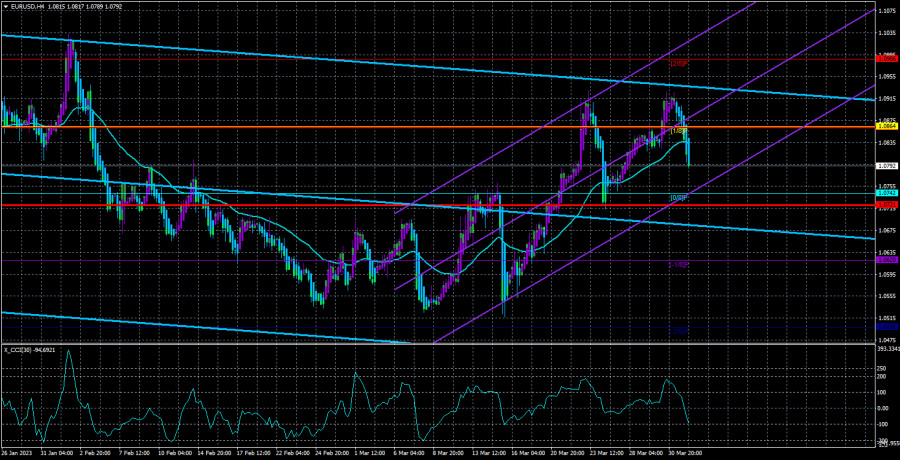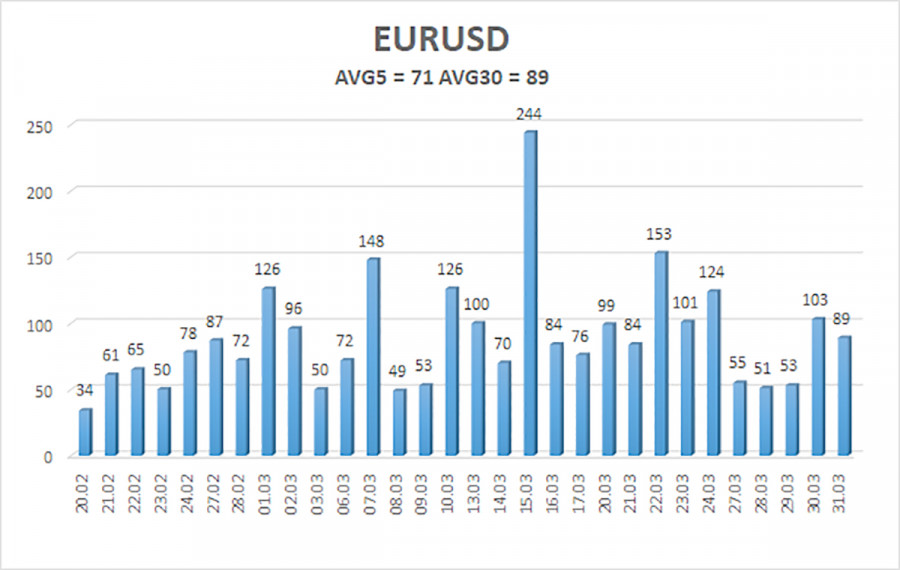
On Friday, the EUR/USD currency pair formally began declining. It began on a day when further development could very well be anticipated. Remember that the fundamental and macroeconomic backgrounds were completely absent for the majority of the previous week. And for almost the entire period, the value of the euro has been rising gradually. Slowly but definitely. On the other hand, an inflation report that was published on Friday signaled the sharpest drop (by 1.6% in annual terms). What do these figures indicate? The fact that the ECB now has much less need to increase the rate aggressively and quickly, goes against the reasoning that has been firmly established in the market over the previous year. Inflation in the US has already decreased to 6%, but the Fed rate is still significantly greater than the ECB rate, and the absolute decline in inflation in the US is lower than that of the EU. And it appears that, in light of this, the value of the euro has decreased completely rationally, but there is another side to the story.
Contrary to inflation in the United States, core inflation has increased once more and has never slowed down. And this is a very delicate subject, in our view. On the one hand, the fact that inflation is generally declining and doing so rapidly is unavoidable. The ECB, on the other hand, bases its calculations more on core inflation, which ignores changes in the cost of electricity and food. And it's not going down. As a result, we could anticipate any movement of the pair on Friday, as we had previously cautioned.
The most intriguing development is the gradual disappearance of the correlation between inflation, rates, and the value of the national currency. The market understands that central banks won't be able to keep raising rates indefinitely. Therefore, if inflation keeps increasing or remains excessive, eventually the Central Bank will just stop paying attention to it. Furthermore, there was plenty of time for the market to adjust to any additional rate rises. Fortunately, in the US and the EU, it is already known how much they can grow.
Separately, we would like to draw attention to the fact that the euro has struggled to adjust regularly following a rise of 1,500 points; on the 24-hour TF, it is typically either in "swing" mode or flat. The pound is the same. As a result, the pair's growth over the past few weeks as a whole appears illogical, and it could decline similarly in the weeks to come.
Preview of the week.
As we've already mentioned, the pair could change in the coming days and weeks without giving much thought to the foundation or macroeconomics. Technical considerations arise first. For less significant complaints, there can only be a local response; for more significant ones, there can be a stronger local response. On Monday, the final value for March's manufacturing business activity indicator in the European Union will be made public. Tuesday has nothing. On Wednesday, the service sector business activity index's final number for March was released. Nothing on both Thursday and Friday. Therefore, there is nothing to observe this week in the European Union.
There will undoubtedly be significant data in the US, but we will discuss those in the article on the pound/dollar exchange rate. Let's assume for the time being that we anticipate a decline back to the level of 1.0530, which marked the start of the most recent upward trend. As of right now, the pair appears to be forming a traditional three-wave correction, and the second wave ended up being slightly stronger than anticipated. The third wave should therefore not be any lighter than the first two. As a result, 1.0530 or less is the desired level. The euro is starting to lose its advantage over the dollar as monetary policy tightening cycles in both the US and the EU are coming to an end. Without a doubt, the ECB will increase interest rates in 2023 a little bit more than the Fed, but this increase will only be "a little" in actuality. Therefore, there are simply no unique causes for the medium-term growth of the euro currency.

As of April 3, the euro/dollar currency pair's average shift over the previous five trading days was 71 points, which is considered "average." So, on Monday, we anticipate the pair will move between 1.0721 and 1.0863. A round of upward corrections will be signaled by the Heiken Ashi indicator's upward turnaround.
Nearest levels of support
S1 – 1.0742
S2 – 1.0620
S3 – 1.0498
Nearest levels of resistance
R1 – 1.0864
R2 – 1.0986
R3 – 1.1108
Trading Suggestions:
The EUR/USD pair has consolidated below the moving average line. Until the Heiken Ashi indicator turns up, you can continue to hold short positions with targets of 1.0742 and 1.0721. After the price is fixed above the moving average line with a target of 1.0986, new long positions may be opened.
Explanations for the illustrations:
Channels for linear regression - help identify the present trend. The trend is now strong if they are both moving in the same direction.
The short-term trend and the current trading path are determined by the moving average line (settings 20.0, smoothed).
Murray levels serve as the starting point for adjustments and movements.
Based on current volatility indicators, volatility levels (red lines) represent the expected price channel in which the pair will trade the following day.
A trend reversal in the opposite direction is imminent when the CCI indicator crosses into the overbought (above +250) or oversold (below -250) zones.











